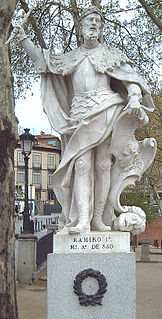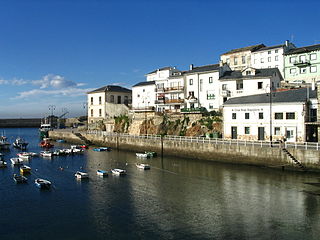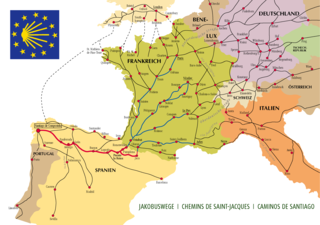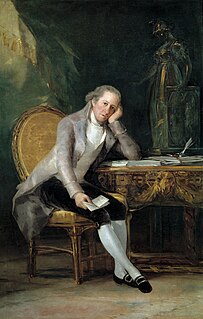
The Kingdom of Asturias was a kingdom in the Iberian Peninsula founded in 718 by the Asturian chief Pelagius of Asturias. It was the first Christian political entity established after the Umayyad conquest of Visigothic Hispania in 718 or 722. That year, Pelagius defeated an Umayyad army at the Battle of Covadonga, in what is usually regarded as the beginning of the Reconquista. The Kingdom of Asturias transitioned into the Kingdom of León in 924, when Fruela II of Asturias became king with his royal court in León.

Gijón or Xixón is the largest city and municipality in the autonomous community of Asturias in Spain. It is located on the Bay of Biscay, approximately 24 km (15 mi) north-east of Oviedo, the capital of Asturias.

Ramiro I was King of Asturias from 842 until his death. He was son of King Bermudo I, and became king after a struggle for succession that followed the death of Alfonso II without issue. He was a contemporary of Abd ar-Rahman II, Umayyad Emir of Córdoba. During his turbulent reign, the chronicles relate that he had to fend off attacks from both Vikings and Moors. Numerous important structures, such as his recreational palace Santa María del Naranco, were built during his reign in the estilo ramirense that prefigured Romanesque architecture.

Avilés is a city in Asturias, Spain. Avilés is with Oviedo and Gijón, one of the main towns in the Principality of Asturias.

The Astures or Asturs, also named Astyrs, were the Hispano-Celtic inhabitants of the northwest area of Hispania that now comprises almost the entire modern autonomous community of Principality of Asturias, the modern province of León, and the northern part of the modern province of Zamora, and east of Trás os Montes in Portugal. They were a horse-riding highland cattle-raising people who lived in circular huts of stone drywall construction. The Albiones were a major tribe from western Asturias. Isidore of Seville gave an etymology as coming from a river Asturia, identified by David Magie with Órbigo river in the plain of León, by others the modern Esla river.

Peñamellera Baja is a municipality in the Autonomous Community of the Principality of Asturias, Spain. It is borderered to the north by Llanes and Ribadedeva, to the west by Peñamellera Alta, and to the east and south by the Autonomous Community of Cantabria.

Carreño is a municipality in the autonomous community of the Principality of Asturias, Spain. It is bordered by Corvera de Asturias on the west, Gozón on the north, the Cantabrian Sea on the north and east, and Gijón on the east and south. Its capital is Candás.

Tapia de Casariego is a municipality in the Autonomous Community of the Principality of Asturias, Spain. It is bordered on the north by the Cantabrian Sea, on the east by El Franco, on the south and west by Castropol. Tapia is also the name of one of the parishes inside the municipality. Its capital is Tapia. The capital, is 127from Oviedo, from Gijón 122 km, 97 km from Lugo, from these cities can reach the council via road N-634, the freeway A-8 (E70), and Ranon the airport in site 86 km from the town, another railroad access is by the railway line FEVE Ferrol - Gijón with stops in La Roda.

The Asturias autonomous football team is the regional football team for Asturias. They are not affiliated with FIFA or UEFA, because it is represented internationally by the Spanish national football team. The team plays only friendly matches.
Asturians are the native ethnic group of the autonomous community of Principality of Asturias, in Spain, as well as smaller communities in the Spanish provinces of León, Zamora and Cantabria.
Yago Yao Alonso-Fueyo Sako, known as Yago Yao, is a former Equatoguinean footballer who played as a central defender.

Bolo palma is a variant of bowls originated and played throughout the region of Cantabria, north of Spain. The basic aim of the game is the knock over as many pins as possible with a wooden ball. Records of the game go back as far as the 16th century. The game was also spread to neighbouring areas of eastern Asturias and northern Palencia. Cantabrian emigration also took the practice of the sport elsewhere in Spain to places such as the Basque Country, Madrid, Catalonia and Andalusia and even to other countries like Mexico, Argentina, Chile and Venezuela.
Grases is one of 41 parishes in Villaviciosa, a municipality within the province and autonomous community of Asturias, in northern Spain.
The King Alfonso XIII's Cup 1926 was the 26th staging of the Copa del Rey, the Spanish football cup competition.

The Bowling Museum of Asturias is located in the Panes parish of Peñamellera Baja, Asturias, Spain. It is dedicated to the sport of bowling in its varied forms, mainly Asturian bowling. Opened 19 April 2003, the museum was pioneered by the municipality of Peñamellera Baja, the Principality of Asturias, and an eastern Asturian consortium.
The Republic's Cup 1931 was the 31st staging of the Copa del Rey, the Spanish football cup competition.
The Regional Championship of Asturias was a football tournament played in Spain, organized by the Asturian Federation. It was played annually between 1916 and 1940 by the clubs affiliated in this.
Sport in Asturias has always been dominated by football. Other popular sport activities include basketball, cycling, handball, volleyball, roller hockey and rugby union. Asturias has also hosted a number of international events such as group stage games during the 1982 FIFA World Cup, series of the Davis Cup World Group, international roller hockey competitions, several cycling states of La Vuelta and several matches of the Spanish national football team.





















